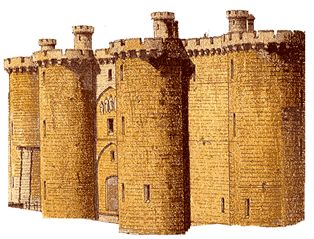SUNDRIES: An eighteenth century newsletter
N° 13 - January 14, 2006
|
| |

GOOGLE PRINT: Enlightenment
This new tool already offers hard to find material, even much French work that can't be found on Gallica, but it definitely has its growing pains. It doesn't help that it has no search by page number, or that the Indexes and
Tables of Contents available from the links at left often... aren't. Using it for 18th century material is even more complicated. But a few tricks can simplify the task:
- I almost always use 'date:1700-1800' after the search term. Certainly not fool-proof (even with a more
dependable database), but it can avoid a lot of extraneous results.
- One big thing to remember is the famous 'long s'. If you can't find a word that contains 'ss' try substituting 'ff'. And vice versa. Etc.
- In French volumes, at least, to find the ACTUAL Table of Contents, search for 'Table' within the book. If there's more than one result, it's probably the last one (French TOCs being at the back).
- Maddeningly, when you DO find a word in the index or TOC, often a search within the book won't find the same word on the referenced page. Try looking for other words that occur on neighboring pages (per the index or TOC) and then stepping through to the right page.
- Finally, if you find something in one volume of a multi-volume series, BOOKMARK THE PAGE. I've already found (and saved) pages from a volume only to have the volume 'disappear' from every subsequent search.
Like I said, growing pains. But I'm still blown away by some of what I've found.

|
|
|
DESKTOP SEARCH: Results in context
How many researchers have now accumulated innumerable documents in text and Word format? Being able to search
through all these is so common a need that all the major search companies - Google, Yahoo, Microsoft, Ask Jeeves - offer desktop search tools for free. Yahoo's so far seems to get the best reviews. Personally, I have yet to get it to do text search, despite setting the relevant parameters (it finds files quite handily). I've had less luck with others. Each also requires indexing, with more or less impact on your system.
Another point is that all, at best, return one snippet of text for each result. If one file includes more than one reference, you have to open the file and do another search inside the file. (Some in fairness seem more designed to find files than what's in them.) Compare this to the technique used by Rutgers on their superb presentation of the Spectator. Try a search on this site, and you'll find that the results, even multiple results from one volume, not only appear in context, but allow you to expand that context. Very nice. But there are a number of reasons the underlying tool (DJVu) wouldn't be suitable for personal use - starting with price.
Having looked around for a desktop tool that would do something like this, I finally found QuickSearcher, originally from www.aks-labs.com, though it doesn't seem to be available there now (check the standard download sites). Quicksearcher doesn't appear to build an index, which is an advantage in that it can be used immediately, but also means it probably uses 'brute force' to find results - that is, it actually scans every file. This means you wouldn't want to use it to search your whole drive, for instance. But if, like me, you keep key research text in a limited set of directories, the search time is far more reasonable.
Best of all, it not only lists every file which contains a result, it shows a snippet (in very raw form) around the first result in a window at bottom and then allows you to STEP THROUGH every result - within one file and on to the next one. This is, in a word, cool. Oh yeah, and it's free. So what's the catch? So far, the only one I've seen is that it pops up an ad for a Files Search Assistant, a more powerful tool that costs $60 (but is also available for a limited trial.) These ads pop up very rarely, certainly not enough to be annoying.
Files Search Assistant itself has some neat features, notably a report listing all the results by file (this only works partially in the demo version.) Strangely, it does NOT let you step through results in one file directly into the next - you have to use a different button. [NOTE: Several tools exist which include the phrase 'Search Assistant'. One was spyware, it seems. This is not that one.] Otherwise, having looked around the Web and seen only praise, and having run some security tools against the directory, I don't see any evidence of skullduggery. For those who would like to see their desktop search results in context and easily be able to go through them, QuickSearcher, or its more powerful cousin, looks like just the ticket.

|
TEXT COLLECTIONS: Canadiana advances search; N&Q's in Gallica
The Early Candiana site is particularly rich for Canadian material (in both national languages), if a bit frustrating sometimes (you can't download full volumes, for instance):
http://www.canadiana.org/ECO?Language=fr
http://www.canadiana.org/ECO
They have now added advanced search, with, notably, a date range feature (at last...).
I don't know when three years of the Notes and Queries appeared on Project Guthenberg, but there the volumes are, not only on the main site but on other sites that repackage its material (such as the somewhat prettier manybooks.net). Certainly easier (and surer) to search than what's available on the Internet Library of Early Journals site:
http://www.bodley.ox.ac.uk/ilej/
(from 1849 to 1869) if less complete, only going from November 1849 to January 1851.

|
ON-LINE ARTICLES: Visible Bodies; The Theosophical Voltaire
This article has some relation to our recent discussion of tattoos:
VISIBLE BODIES: POWER, SUBORDINATION AND IDENTITY IN THE EIGHTEENTH-CENTURY ATLANTIC WORLD By Gwenda Morgan and Peter Rushton University of Sunderland:
In the eighteenth century the developing print culture made bodies, particularly the bodies of the poor, the troublesome and the criminal, more noticeable than ever before. While bodies in the early modern period were subject to inspection under many different circumstances (as Gowing has shown), mostly when their owners had come under suspicion or their identity into question, what made the eighteenth century distinctive was that the results of these scrutinies became public in a culture of advertisement...
I know little about Theosophy but for our theosophical dix-huitiemistes, there's:
Voltaire .. . Cynic, Humanitarian, Esotericist?
The stereotype of the French poet and philosopher Voltaire is that of the wit, cynic and unbeliever, the man of cool reason, who would have laughed in God's face had he met him. With all due admiration for the lucidity of his writings and his unmatched erudition in a wide range of fields, few have inquired what was behind the mocking mask of this
"infidel," whose pen thrusts made many a crowned head of his era tremble.

|
TECHNOLOGY: Bikes and Cars
It is surprising, in retrospect, that the bicycle was not invented in the 18th century, which already had wheels, chains, and other elements that would have worked for at least a basic two-wheeled vehicle. Even more surprising is that something very like a car - or if you prefer a steam locomotive - WAS invented, even if it had some kinks to work out. The Revue Encyclopedique of 1891 has an article (195-203) on "Velocipedie" which traces the history of bike-like contraptions, but in so doing touches on at least one precursor to the car as well. It includes an engraving of a famous stained glass window (from the time of Cromwell) at Stoke Poges that shows an angel on something like a small bike:
http://www.stoke-poges.com/church/steined.shtml
(Thomas Gray is buried in the town, as it happens.) It also refers - skeptically - to a XVIIth century account by Henry Fetherstone of a bike-like construction by a Jesuit named Ricius. The account gets more concrete with a mention of a paper read in 1693 by Jacques Ozanam that described a wheeled vehicle powered by a valet standing at the back and pedaling. The article also shows an image of this contraption, which the following site says he had built in 1696:
http://www.csdm.qc.ca/Baril/Sixieme/Archives02-03/inventions/automobile.htm
It's a toss-up whether this could be considered a precursor of the bicycle (because of the pedals) or a primitive car (because of the general configuration). The article also mentions a "celerifere" built by de Sivrac in 1690 that sounds very much like a bicycle - or like Ricius' less-documented contraption. The rest of the article is mainly about the
history of the bicycle (with some very nice images of various old models, whether or not you can read the French.) Now, for the invention of the horseless carriage....
The first steam carriage seems to have been made by a Frenchman, Cugnot, in 1760, that same marvellous year which witnessed the birth of Napoleon L, Wellington, Humboldt, Mehmet Ali, Lord Castlereagh, Sir E. I. Brunel, Cuvier, and the first patent of Arkwright, the first patent of Watt, as also some other events almost as great in their eventual influence on the present eras. An engine made by Cugnot is still in existence in the Conservatoire des Arts et Metiers at
Paris. It has a copper boiler, very much like a common kettle without the handle and spout, furnishing with steam a pair of 13-in, single-acting cylinders. The engine propels a single driving wheel, which is roughened on its periphery. Altogether, this engine bears considerable testimony to the mechanical genius of its inventor.
(Scientific American. 1865/ New Series, Volume 12, Issue 10. (148))
Nicolas Joseph Cugnot was an army officer and apparently built this as a dray to carry cannons - a dray with front-wheel drive:
This dray was a carriage with three wheels, one in front, and two fixed upon an axle behind. The motive power was applied to the front wheel. This was made to bear the weight of the boiler, the water, and also the furnace, which
was made of sheet-iron lined with fire-proof earth. The front wheel could be turned at right angles to the hind part, so that the dray could turn as easily as if it was drawn by horses. All modern engineers have applied the motive power to the hind wheels. The author alone, more than twenty years ago, attempted to apply the motive power in front.
(Scientific American. 1866 / New Series, Volume 15, Issue 4. (47))
He showed it to the Marshal de Saxe in 1763, and then built a similar model at the king's expense. "But when set in motion, it projected itself onward with such force, that it knocked down a wall which stood in its way.." (The Mechanical Inventions of James Watt, by J. P. Muirhead, M.A. Stuart's Historical and Descriptive Anecdotes of Steam-Engines, and of their Inventors and Improvers. (208-209)) Though Cugnot was in the lead in inventing what sounds very much like a steam-powered automobile, he quickly had company in other countries, starting with James Watt:
Watt... in the specification of his patent of 1769, gave a description of an engine of the kind suggested by his friend Robinson, in which the expansive force of steam was proposed as the motive power. It also appears that other inventors were in the field about the same time; for in a letter written by Dr. Small to Mr. Watt, on the 18th of April,
1769, it is stated that "one Moore, a linen-draper of London, had taken out a patent for moving wheel-carriages by steam;" but no steps were taken to reduce the invention to practice.
(The Mechanical Inventions of James Watt.)
Later, in 1784, Watt "patented a locomotive engine, the boiler of which was to be of wood, hooped like a beer barrel. Watt, however, had not much faith in steam carriages, and he objected to the attempts made in this direction, in 1784, by William Murdoch, his veryable assistant." (Scientific American, 1864 (148)). The latter "was on the high-pressure principle, and ran on three wheels. The boiler was heated by a spirit-lamp; and the whole machine was of very diminutive
dimensions, standing little more than a foot high. Yet, on one occasion, the little engine went so fast that it outran the speed of its inventor." (London: Sherwood, Gilbert and Piper, 1833. Biographical paper on William Murdoch, read by Mr. William Buckle, of Soho, before the Institute of Mechanical Engineers, October, 1850. Smiles, Samuel, The life of George Stephenson, railway engineer,1812-1904. (63-64) ) Meanwhile, in America:
Oliver Evans was also occupied with the same idea; for, in 1772, he invented a steam-carriage to travel on commonroads; and in 1787 he obtained from the State of Maryland the exclusive right to make and use steam-carriages. His invention, however, never came into practical use.... It also appears that, in 1784, William Symington, the inventor of the steam-boat, conceived the idea of employing steam power in the propulsion of carriages; and in 1786 he had a working model of a steam-carriage constructed, which he submitted to the professors and other scientific gentlemen of Edinburgh. But the state of the Scotch roads was at that time so horrible, that he considered it impracticable to proceed further with his scheme, and he shortly gave it up in favor of his project of steam-navigation."(Buckle/Smiles)
So near, yet so far.. Just think: instead of griping about prices at the pump, we could all be kvetching about the cost of a cord of wood.

|
From CHEZ JIM Books:
An EIGHTEENTH CENTURY VEGETARIAN COOKBOOK:
APRES MOI LE DESSERT - VOLUME II
and a history of the CROISSANT:
AUGUST ZANG AND THE FRENCH CROISSANT
|


18th CENTURY RECIPE: Ket-chop
I was drawn up short when I found this entry in the Art of Cooking (L'Art du Cuisinier, 1814). It probably shouldn't be a surprise to find ketchup already in the 18th century, nor ketchup made of mushrooms - which apparently in England it still sometimes is: http://www.ochef.com/133.htm A bit more surprising is that a French cookbook would have used a word so close to our own. "Catsup" is the pre-ketchup word I've most seen referenced. The Notes and Queries (Number 18, March 2, 1850) does list this variant, but it may well be for the same recipe given here (in Viart, rather than L'Art Du Cuisinier):
Catsup (no. 8. p. 125.).--"Catsup" is to be found thus spelt in Todd's Johnson's Dictionary (London, 1818). He describes it as a kind of Indian pickles imitated by pickled mushrooms; and quotes these two lines of Swift: "And for our home-bred British cheer, Botargo, catsup, and cavier." An eminent Sanscrit scholar informs me that "kuck-hup" is the Hindostanee word for Turtle; it is to be met in the Vocabulary attached to Gilchrist's East Indian Guide (8vo. London,
1820). May not the name of the sauce take its origin from the use of it in preparing the turtle for the table? In the _Cuisinier Royal, par Viart_, p. 75., it is mentioned among the "petites sauces," as ket-chop, "ou Soyac;" and the receipt for making it ends with "servez le avec le poisson." (Published at Paris, 1840.)
It turns out however that the English, at least, had it from before 1728 when it was published in Richard Bradley's The Country Housewife and Lady's Director (142-143):
To make Mushroom Ketchup Take the Gills of large Mushrooms, such as are spread quite open, put them into a Skellet of Bell-Metal, or a Vessel of Earthen-Ware glazed, and set them over a gentle Fire till they begin to change into
Water; and then frequently stirring them till there is as much Liquor come out of them as can be expected, pressing them often with a Spoon against the side of the Vessel; then strain off the Liquor, and put to every Quart of it about eighty Cloves, if they are fresh and good, or half as many more, if they are dry, or have been kept a long time, and about a Drachm of Mace: add to this about a Pint of strong red Port Wine that has not been adulterated, and boil them all together till you judge that every Quart has lost about a fourth Part or half a Pint; then pass it thro' Sieve, and let it stand to cool, and when it is quite cold, bottle it up in dry Bottles of Pints or Half-Pints, and cork them close, for it is the surest way to keep these kind of Liquors in such small quantities as may be used quickly, when they come to be exposed to the Air, for fear of growing mouldy: but I have had a Bottle of this sort of Ketchup, that has been open'd and set by for above a Year, that has not received the least Damage; and some Acquaintance of mine have made of the same sort, and have kept it in Quart-Bottles to use as occasion required, and have kept it good much longer than I have done. A little
of it is very rich in any Sauce, and especially when Gravey is wanting: Therefore it may be of service to Travellers, who too frequently meet with good Fish, and other Meats, in Britain, as well as in several other parts of Europe, that are spoiled in the dressing; but it must be considered that there is no Salt in this, so that whenever it is used, Salt, Anchovies, or other such like relishing things, may be used with it, if they are agreeable to the Palate, and so likewise with the Mushroom Gravey in the following Receipt.
And for a French version, from about eighty years later, here is the recipe from the L'Art du Cuisinier (72-73):
Take twelve maniveaus [a basket holding 5-6 mushrooms] of mushrooms, peel them, wash them, slice them as small as possible, take a new pantry terrine; make a bed of mushrooms about the thickness of a finger; sprinkle it lightly with fine salt, in the same way, layer by layer, until your mushrooms are used up; add a handful of walnut hull [brou de noix, also a liqueur made from this]. (Regarding hull, see the entry on Pig, how to give a domestic pig the look and taste of wild boar.) This done, cover your terrine with any dish, let the mushrooms soften together for four or five days; draw off the liquid and squeeze out the marc by sheer force, through a new cloth (this requires two people): put this liquid in a casserole: reduce it; add two laurel leaves; you will have marked a small stewpot as for making a base of 'glace' [meat glaze, a much reduced and clarified consomme]...Once it is cooked, strain it through a strainer; skim off the grease; put together this mushroom liquid and the base of glace (or if you prefer put in glace); add four or five crushed anchovies; a coffee spoon of Cayenne pepper; reduce all this almost to a demi-glace; take out the laurel leaves, and let it cool; then put it in a new bottle, well-corked, and serve it with fish."

|

|
 FOR READERS OF FRENCH FOR READERS OF FRENCH

LIENS: Foire aux Texts; Culture.fr
This site, from the French Foreign Minister, offers a limited set of passages by famous authors in French: Foire aux Textes
This, one of several sets of links from the Ministry of Culture and Communication's Culture.fr site, focuses on literature and books:
http://www.culture.fr/Groups/livre_et_litterature/home

|
PRIVATE LIFE: Limousin domestic registers
If you've never dipped into livres de raison or other household registers, the experience can go from plodding tedium to
sparkling surprise. A lot depends on the family in question, the laconicism or (rarely extensive) volubility of the writer, the interest of local events, etc. Also, human interest aside, for prices, they are often invaluable. Gallica recently put up two volumes of such registers from the Limousin/La Marche region, spanning a number of centuries: Nouveau recueil de registres domestiques limousins et marchoi 1895. Most that start in or extend into our own century are in the latter half of the second volume. One interest of this particular collection is that it crosses different milieux:
- A surgeon-apothecary (1675-1718), with notes of what he prescribed - 159
- A priest (1677-1702), including costs he paid for his nephew - 169
- A lawyer (1660-1730), with details of a funeral for his son - 185
- A lord (1706-1710), taking care of his granddaughter - 202
[the dates are those of the documents available] The above of course being only some of the entries. There's a judge, an intendant, merchants, several bourgeois, a family that appears of modest means, etc.
For more (in French) about the region's history:
http://www.planete-tina.com/genealogie/lelimousin/limousin/limousin.htm.

|

|
End quote
|
"It is with things that one can neither see nor feel that it is important to guard against flights of imagination."
Lavoisier
Robert Darnton's translation
|
|
|






